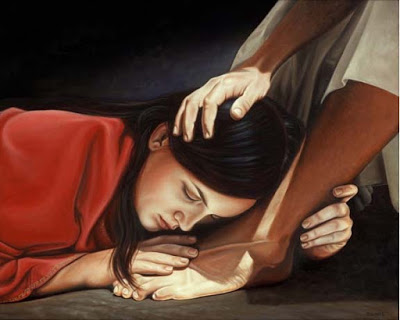Sermon for Sun 6 April / Lent 5
Reading: John 12:1-8 (also referencing Matthew 26:6–13, Mark 14:3, Luke 7:36–50, John 11, Luke 10:38-42)
This morning we get to focus on a woman in the Bible who we know so little about but who had profound encounters with Jesus and who Jesus said will always be remembered. We see Mary of Bethany a few times and they are all in a family home. And we’re going to take a look at 3 passages in which we read about her.
Luke has a slightly different order of events, but essentially we first meet Mary, and her sister Martha in Luke 10. It’s the passage where Jesus visits Martha’s home, she welcomed him in Luke tells us. Mary sits at Jesus’ feet learning from him, while Martha complains that she is left to do all the work herself.
Then in John 11 we learn of Lazarus’ death. He is the brother of Mary and Martha. Lazarus was ill and they sent for Jesus but he didn’t come for another 2 days, later saying ‘our friend Lazarus has fallen asleep, but I am going there to awaken him’. When he arrives Mary does not go out to meet him as Martha does, But when he calls for her she falls at his feet, and says ‘Lord, if you had been here, my brother would not have died. But of course we know he goes on to raise Lazarus to life again. And here in John 12 (actually in all 4 gospels) we see Mary anointing Jesus’ feet with perfume.
We look at this passage today in the lectionary in the run up to Easter, teaching usually follows that she was preparing him for death, for burial, but there is so much more to Mary’s story than this moment. Her story is woven through these encounters, her relationship with Jesus, her journey of faith. So often we see this in the Bible, that if we connect the dots and follow the stories of individuals, we learn so much more than from an isolated passage.
I think it’s interesting that in all three of these accounts Mary is at the feet of Jesus.
In the first we see:
Mary… sat at the Lord’s feet and listened to what he was saying. Luke 10:39
She sat at the Lord’s feet.
She had made a choice (criticised by her sister) to sit and learn from this wonderful teacher rather than helping Martha. We can imagine Martha, being a good host, preparing drink and food for the guests. But Mary wanted to learn, to know more of who this man was, she was drawn to him and sat at his feet listening.
In the second instance, when Lazarus has died, Mary stays at home only going to meet Jesus when he asks for her but we read she comes to him and she kneels at his feet crying and saying: if only you’d been here (John 11:32)
She kneels at his feet
And finally here in John 12 Mary sits at Jesus’ feet again, we read:
Mary took a pound of costly perfume made of pure nard, anointed Jesus’ feet, and wiped them with her hair.
She sits at his feet
This time it is an act of devotion. In Luke’s version she even uses her own tears to wipe his feet before anointing them. Mark and Matthew both have Jesus saying she is preparing him for burial, and that ‘wherever the good news is proclaimed in the whole world, what she has done will be told in remembrance of her.‘
Mary has learned from sitting at Jesus feet, she knows to call for him to save her brother, and here towards the end, she carries out this prophetic act, an act of extravagant worship, of devotion, of familarity, of love. She takes the role that would traditionally happen after death. Friends, family, often women, would wash and prepare the body with oil, spices and fabric.
Mary knows who Jesus is and she knows what is to come.
That’s why she sits at his feet.
There’s something else to note in these passages, something which takes us deeper into imagining what was happening.
In the first, while Mary sits at Jesus feet, Martha is a good host. We might imagine her working over a fire, the smell of a meat stew or bread cooking, wafting through the house.
This fragrance of home, of hospitality, of service.
In the second we read that they go to the tomb. When Jesus calls for the stone to be taken away Martha says no, there will be too strong a smell – he’s been dead 4 days.
The smell of death permeating the air.
But within this foul smell, this fragrance of death, Jesus performs a miracle for them all to see. New life from death.
And finally, in today’s passage, the smell of death is long gone but the fragrance of the perfume prepares for the next death. The one for which Mary prepares Jesus. A smell which would have evoked in those present, memories of death, of those they themeslves prepared after death, or had smelled at a burial. Just as when you go home today you might notice the lingering smell of incense, and it might remind you of church, worship, or prayer.
In each of these encounters there is also a misunderstanding of who Jesus is or of what is going on. In the first one Jesus tells Martha you are too distracted – ‘Mary has chosen the better part, which will not be taken away from her’.
Martha has not yet realised the significance of who Jesus us. Mary on the other hand wants to sit and learn from him, she knows there is someting important about him
In the second, Mary and Martha both tell Jesus, you should have beeen here, Lazarus wouldn’t have died. But Jesus has said to his disciples John 11:4
‘This illness does not lead to death; rather it is for God’s glory, so that the Son of God may be glorified through it.’
and vs 14-14
Then Jesus told them plainly, ‘Lazarus is dead. For your sake I am glad I was not there, so that you may believe. But let us go to him.’
There was a much bigger story at play here they had not yet understood.
And in today’s passage, Mary is criticised for pouring the perfume on Jesus, Judas misundertdands, he just does not get it. He doesn’t understand why the perfume was ‘wasted’ in this way. But Jesus says, ‘Leave her alone. She bought it so that she might keep it for the day of my burial. You always have the poor with you, but you do not always have me’
I find Mary’s story so moving, that picture of her just sat at Jesus feet, a sign of reverence to him as a teacher, a sign of service and obedience, of listening and learning. And going from that to a place of total understanding, of worship and devotion, of costly giving.
In Luke we read: ‘She stood behind him at his feet, weeping, and began to bathe his feet with her tears and to dry them with her hair. Then she continued kissing his feet and anointing them with the ointment.’
Of all those present, she knows who Jesus is. She knows who she is in Christ and she gives of her all.
So we see Mary’s story is so rich, and all of these encounters happen within the context of home. Hers or Martha’s or the family home, we don’t know, but it is in this place that Jesus meets with them. Her experiences happen within the place of life, family, community, and everyday happenings, the smells of life happening around her. Jesus comes into this. Just as he does for each of us. It is in this place Mary grows as a disciple of Christ, she learns from him, sees his miraculous nature. She goes from misunderstanding to stepping into her calling, acting prophetically for Jesus’ future.
So what about us?
The challenge to us from Mary’s encounters ?
Do we meet with Christ in the space of our own homes?
Do we take time to metaphorcally sit at Jesus feet and learn from him in the details of our everyday lives?
Do we give of our all to Jesus?
Not because we should or out of guilt or religion, but because we truly know who Christ is?
My prayer for us all this Easter is that we each have a fresh revelation or understanding of Jesus. And who we are in Christ.
Amen




No Comments